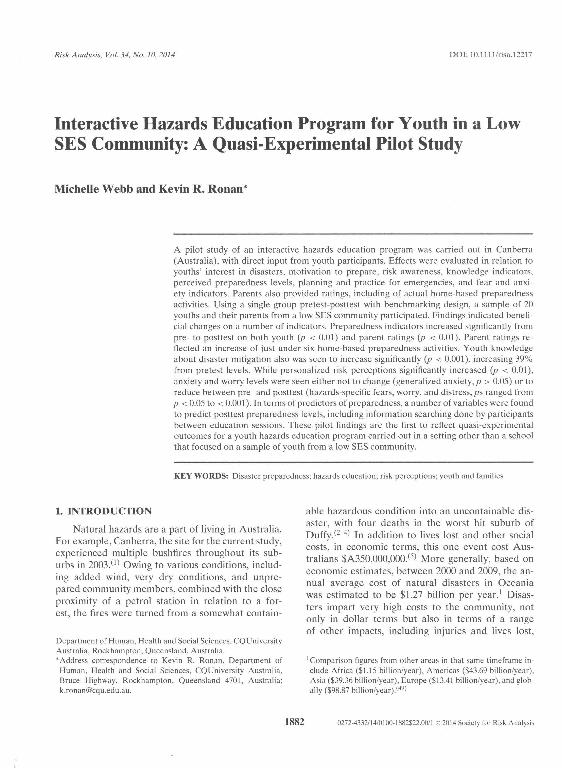Interactive hazards education program for youth in a low SES community : a quasi-experimental pilot study

Contenido multimedia no disponible por derechos de autor o por acceso restringido. Contacte con la institución para más información.
| Tag | 1 | 2 | Valor |
|---|---|---|---|
| LDR | 00000cab a2200000 4500 | ||
| 001 | MAP20150001566 | ||
| 003 | MAP | ||
| 005 | 20150128170004.0 | ||
| 008 | 150112e20141006esp|||p |0|||b|spa d | ||
| 040 | $aMAP$bspa$dMAP | ||
| 084 | $a7 | ||
| 100 | 1 | $0MAPA20150002327$aWebb, Michelle | |
| 245 | 1 | 0 | $aInteractive hazards education program for youth in a low SES community$b: a quasi-experimental pilot study$cMichelle Webb, Kevin R. Ronan |
| 520 | $aA pilot study of an interactive hazards education program was carried out in Canberra (Australia), with direct input from youth participants. Effects were evaluated in relation to youths' interest in disasters, motivation to prepare, risk awareness, knowledge indicators, perceived preparedness levels, planning and practice for emergencies, and fear and anxiety indicators. Parents also provided ratings, including of actual home-based preparedness activities. Using a single group pretest-posttest with benchmarking design, a sample of 20 youths and their parents from a low SES community participated. Findings indicated beneficial changes on a number of indicators. Preparedness indicators increased significantly from pre- to posttest on both youth (p < 0.01) and parent ratings (p < 0.01). Parent ratings reflected an increase of just under six home-based preparedness activities. Youth knowledge about disaster mitigation also was seen to increase significantly (p < 0.001), increasing 39% from pretest levels. While personalized risk perceptions significantly increased (p < 0.01), anxiety and worry levels were seen either not to change (generalized anxiety, p > 0.05) or to reduce between pre- and posttest (hazards-specific fears, worry, and distress, ps ranged from p < 0.05 to < 0.001). In terms of predictors of preparedness, a number of variables were found to predict posttest preparedness levels, including information searching done by participants between education sessions. These pilot findings are the first to reflect quasi-experimental outcomes for a youth hazards education program carried out in a setting other than a school that focused on a sample of youth from a low SES community. | ||
| 650 | 4 | $0MAPA20080550424$aDesastres | |
| 650 | 4 | $0MAPA20080544348$aJóvenes | |
| 650 | 4 | $0MAPA20080547233$aFamilias | |
| 650 | 4 | $0MAPA20080598457$aProgramas educativos | |
| 650 | 4 | $0MAPA20080596125$aEducación preventiva | |
| 650 | 4 | $0MAPA20080602871$aPercepción del riesgo | |
| 650 | 4 | $0MAPA20080614539$aInvestigación científica | |
| 650 | 4 | $0MAPA20080592042$aModelos matemáticos | |
| 650 | 4 | $0MAPA20080591182$aGerencia de riesgos | |
| 700 | 1 | $0MAPA20080146450$aRonan, Kevin R. | |
| 773 | 0 | $wMAP20077000345$tRisk analysis : an international journal$dMcLean, Virginia : Society for Risk Analysis, 1987-2015$x0272-4332$g06/10/2014 Volumen 34 Número 10 - octubre 2014 , p. 1882-1893 |

